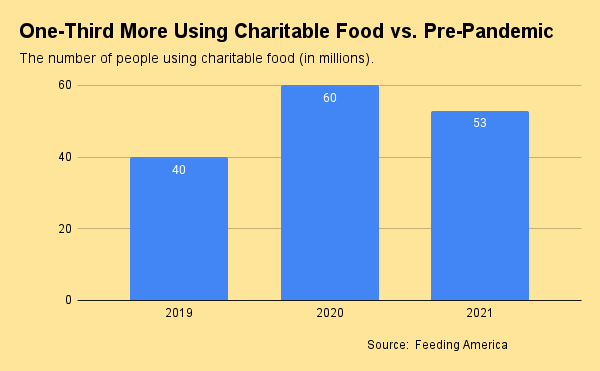
Demand for Charitable Food Remains Unnaturally High
Food banks agree that demand for food assistance has remained unusually high, even as the pandemic has eased. Now Feeding America has put a number on that demand.
In a report released last week, it found that an estimated 53 million people received charitable food assistance in 2021. That’s down from 60 million in 2020 when the pandemic was raging, but still well above the 40 million who received charitable food in 2019. Put another way, 33% more people were still getting charitable food in 2021 versus before the pandemic.
Rising prices, combined with the pullback of many pandemic-related government food assistance programs, mean that high demand for charitable food is continuing into 2022. Eighty percent of the 200 food banks in the Feeding America network say demand for food assistance has increased or stayed the same from March 2022 to April 2022.
“Local food banks, food pantries, food shelves and other community food programs have become an essential piece of a household’s food budget,” noted Claire Babineaux-Fontenot, CEO of Feeding America, in a press release.
Feeding America’s findings are borne out in other, more local reports. The Greater Boston Food Bank, for example, found in a survey released in June that 46% of food-insecure adults in Massachusetts used a food pantry in 2021, up significantly from 32% in 2020, and 27% in 2019.

Similarly, Kyle Waide, President and CEO of Atlanta Community Food Bank, testifying last week at a House Agriculture Committee hearing on nutrition assistance, said his food bank distributed the same volume of food during April and May of 2022 as it did during those same two months in 2020, which was nearly 35% higher than pre-pandemic levels.
Food banks are recommending a broad array of interventions to reduce the need for food assistance. Capital Area Food Bank, in its own report released in June laid some responsibility for fixing the hunger problem on the private sector.
The food bank urged companies to pay living wages, offer paid leave, and ensure upward mobility for workers, echoing similar thoughts expressed by Stacy Dykstra, CEO of Regional Food Bank of Oklahoma, in this article. “Companies have incredible influence over the problem of food insecurity … through their employment strategies,” Capital Area Food Bank said in its report.
At the government level, Capital Area Food Bank recommends permanently expanding the earned income tax credit and child tax credit, and finding ways to drive greater enrollment in SNAP (only one in five food-insecure households in the D.C. area use it) and to make more people eligible for social safety net programs, such as easing qualifications for college students and military families. The food bank also thinks that partnerships between social service organizations, such as food banks and healthcare clinics, can go a long way toward addressing hunger.
Greater Boston Food Bank centered many of its recommendations around improving the food pantry experience. It urged pantries to focus on best practices, such as paying extra attention to Black, Latino and LGBTQ communities; providing food in convenient, dignified and equitable ways; exploring alternative methods of delivery like grocery cards and home delivery, and partnering with other community-based organizations. It also highlighted the need for adequate funding of government programs like SNAP and WIC.
In his testimony, Waide focused mostly on TEFAP, urging mandatory funding of $450 million for the program in the next Farm Bill, as well as $200 million for TEFAP storage and distribution. He noted that Atlanta Community Food Bank next year expects to purchase nearly 25% more food (17.5 million pounds) than it will get through TEFAP (14 million pounds). The purchases will cost it nearly $15 million, and presage a pattern the food bank believes is unsustainable, he said.
The 14 million pounds of food the food bank will get through TEFAP in fiscal 2023 represents about one-third of the government food it received during 2021, Waide said. In addition, the amount is about one million pounds less than what the food bank received from the government pre-pandemic. A further complication is that about 13% of TEFAP shipments the food bank ordered this year have been canceled due to supply chain issues, he said.
In closing, Waide urged the committee to “flood the zone” with access to food. “Doing so will help our families, communities and our country recover faster.” – Chris Costanzo
This article was made possible by the readers who support Food Bank News, a small, editorially independent 501(c)(3) nonprofit media organization. Food Bank News is not funded by any government agencies, nor is it part of a larger association or corporation. Your support helps ensure the continuation of our solutions-oriented coverage of best practices in hunger relief. Thank you!
No comments:
Post a Comment